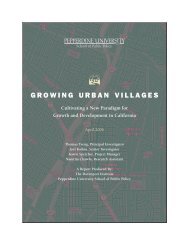Finding Permanent Homes for Adoptable Children - Pepperdine ...
Finding Permanent Homes for Adoptable Children - Pepperdine ...
Finding Permanent Homes for Adoptable Children - Pepperdine ...
You also want an ePaper? Increase the reach of your titles
YUMPU automatically turns print PDFs into web optimized ePapers that Google loves.
Similarly, large families, with three or more children in the home, are growing. The number of large<br />
families, which decreased from 10.4 million in 1970 to 6.5 million in 1990, increased again in 1994 to 7.1<br />
million. As the trend toward larger families rises, more families may consider adding to their existing<br />
biological families through adoption. A 1994 survey of adoptive families in New York State revealed<br />
that 81.4 percent of the families who adopted children with special needs already had children in the<br />
home. Of those adoptive families with other children in the home, the mean number of children was 2.28.<br />
These families were much more likely to adopt older children than families without other children in the<br />
home. 7 By targeting and recruiting these groups across state lines, the expectation is that more children<br />
could be placed in permanent homes. The Interstate Compact on the Placement of <strong>Children</strong> (ICPC) is<br />
precisely the tool to meet that end. It is to a more detailed explanation of that compact that we now turn.<br />
What is the Interstate Compact on the Placement of <strong>Children</strong> (ICPC)?<br />
During the 1950’s, a group of east coast social service administrators in<strong>for</strong>mally joined together to study<br />
the problems associated with moving children out of state <strong>for</strong> foster care or adoption. Among the<br />
problems they identified was the failure of importation and exportation statutes enacted by individual<br />
states to provide protection <strong>for</strong> children. They recognized that a state’s jurisdiction ends at its borders and<br />
that a state can only compel an out-of-state agency or individual to discharge its obligations toward a<br />
child through a compact. The administrators were also concerned that a state to which a child was sent<br />
did not have to provide supportive services even though it might agree to do so on a courtesy basis. In<br />
response to these and other problems, they drafted the ICPC and in 1960 New York signed on as the first<br />
state to enact the compact (<strong>for</strong> the complete text of the ICPC see Appendix C).<br />
The Interstate Compact on the Placement of <strong>Children</strong> (ICPC) is statutory law, or an agreement, in all 52-<br />
member jurisdictions, and serves as a binding contract between members. As of January 1, 2001, those<br />
signed on to the compact included all fifty states, the District of Columbia, the U.S. Virgin Islands and<br />
Puerto Rico (registered as one jurisdiction). The compact’s primary goal is to coordinate the transfer of<br />
children across state lines and see that all children placed out-of-state receive the same protections and<br />
services that would be provided if they remained in their home states. The ICPC establishes legal and<br />
administrative procedures governing the interstate placement of children in order to meet the<br />
jurisdictional, administrative and human rights obligations of all parties involved in interstate placement.<br />
The compact contains 10 articles that establish procedures to be followed in making interstate placements<br />
7 Freundlich, Madelyn, Re<strong>for</strong>ming the Interstate Compact on the Placement of <strong>Children</strong>: A new Framework <strong>for</strong> Interstate<br />
Adoption, The Evan B. Donaldson Adoption Institute. 1999. www.adoptioninstitute.org/policy/inters1.html<br />
4












